Ever tried companion planting? It’s like matchmaking for your herbs!
I’ve got to say, nothing beats pairing basil with tomatoes—pest-repelling and downright delicious! Of course, I learned the hard way that throwing basil and sage together is like inviting your in-laws to dinner—you just know chaos will ensue.
When I grouped my herbs in pots that met their water and sunlight needs, it created this magical little garden. Let’s get real—why settle for a mediocre garden when you can have a sensory explosion? Are you ready to dive into the green goodness?
Designing a Garden That Thrives: A Personal Journey
A few years back, I struggled to understand garden design. My poor herbs were like teens trying to fit in at a high school dance—lost and confused!
After many failed attempts, I finally found a rhythm. I grouped my fragrant basil with sun-loving tomatoes in one section, while the cool dill and cilantro basked elsewhere. Creating zones based on their water needs made all the difference!
Now, when I step out, my garden is a feast for the senses. It’s colorful, aromatic, and vibrant. And hey, if I can turn my gardening disasters into successes, so can you! Let’s transform your garden into a flourishing haven, one herb at a time!
Quick Takeaways
- Pairing basil with tomatoes enhances flavor and deters pests, promoting overall plant health in your herb garden.
- Dill and cilantro complement each other’s growth and flavors, supporting a thriving herb ecosystem.
- Avoid planting basil with sage as they compete, potentially stunting basil’s growth.
- Choose pots with breathable materials to support healthy root systems and improve drainage.
- Seasonal pairings like rosemary with root vegetables in autumn enhance culinary depth and flavor.
Benefits of Companion Planting in Herb Gardens
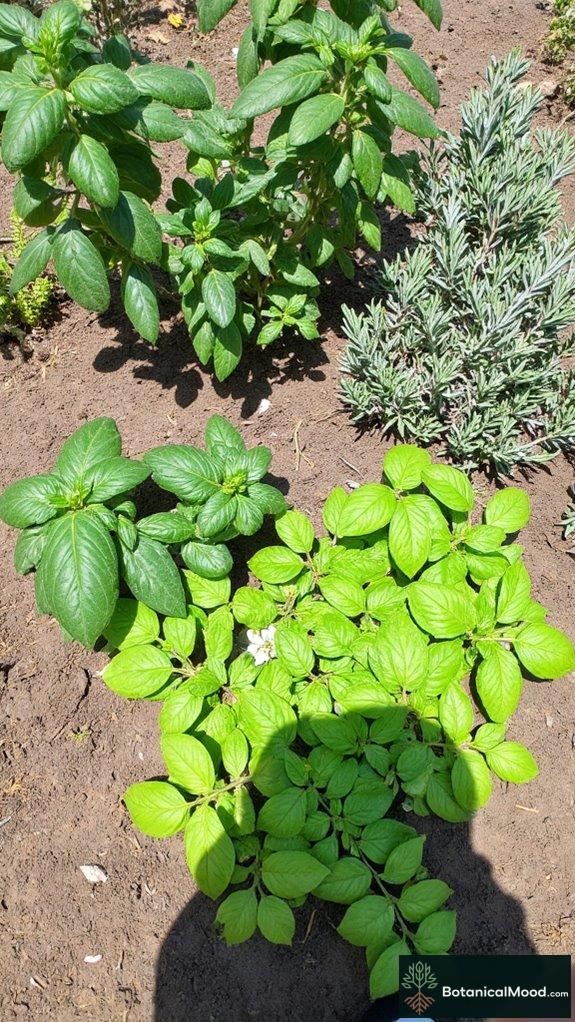
While many gardeners revel in the beauty of individual herbs, I’ve found that embracing the art of companion planting can elevate the herb garden experience considerably. This harmonious approach creates a vibrant tapestry of colors and aromas, allowing each plant to thrive. For example, pairing basil with tomatoes enhances both flavor and growth, as basil deters pests while bolstering the tomatoes’ health. Furthermore, the aromatic companions, like rosemary and sage, can repel unwanted insects naturally, fostering a healthier garden environment. These thoughtful pairings deepen my appreciation for nature’s complex design, a journey I cherish in my collection at Botanical Mood. Additionally, incorporating diverse companion plantings can maximize space and resources, leading to more productive harvests.
Essential Herb Pairings for Maximum Growth

To maximize growth potential in your herb garden, it’s essential to understand the synergy created by strategic plant pairings.
For instance, basil and tomatoes thrive together, the basil enhancing the tomato flavors while also deterring pests, creating an aromatic alliance that’s hard to resist.
Another perfect match is dill and cilantro; their flavors compliment each other while promoting healthy growth.
I’ve always found that when I place these herbs side by side, they flourish beautifully, creating a lush tapestry that not only serves culinary purposes but also enriches the garden’s aesthetic.
Forbidden Combinations: Herbs to Avoid Together
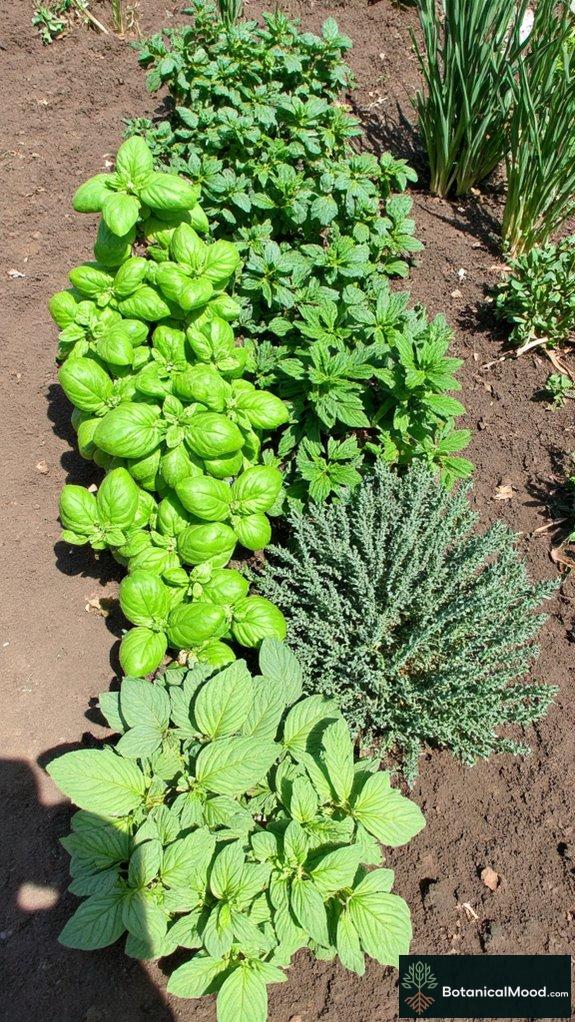
Understanding which herb combinations to avoid is just as important as knowing those that thrive together.
Some herbs simply clash, negatively affecting growth and flavor. For instance, basil and sage don’t harmonize well, with basil often stunting sage’s growth.
Likewise, mint’s invasive nature can overwhelm neighboring companions like thyme or rosemary.
Another pairing to steer clear of is chives alongside beans; their interaction may inhibit growth.
As I curated my own Botanical Mood, I found these pairings essential for creating a thriving, harmonious herb garden.
Container Guidelines for Herb Companions
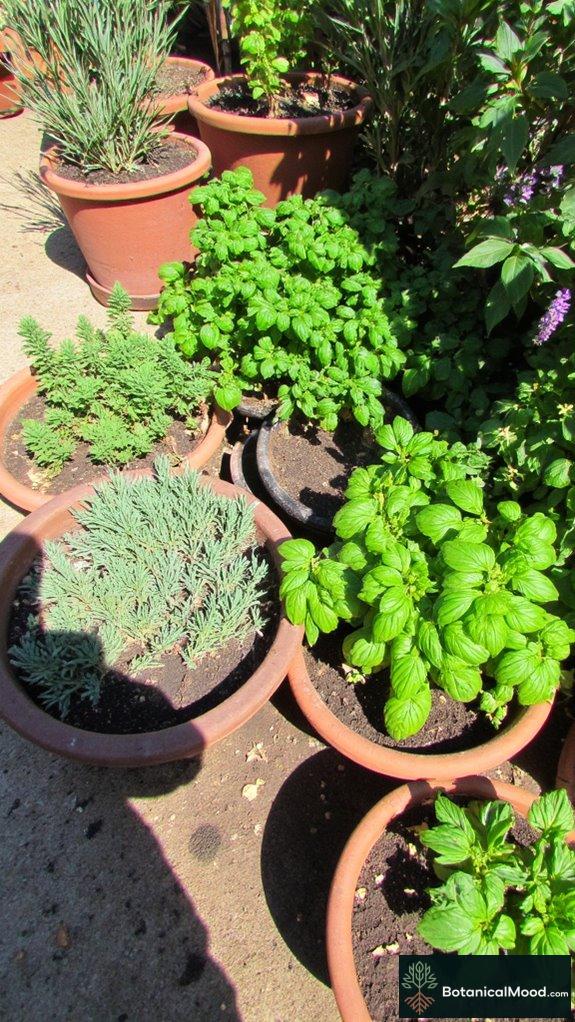
Creating a thriving herb garden in containers requires careful consideration of the right companions to maximize growth and flavor.
When I select containers, I opt for breathable materials like clay or terracotta that allow roots to thrive. It’s important to group herbs with similar water and sunlight needs; for instance, basil loves full sun while cilantro prefers partial shade.
Choosing breathable containers and grouping herbs by their sunlight and water needs creates the perfect environment for thriving plants.
I often combine aromatic herbs like thyme and rosemary, which deter pests and enhance each other’s flavors. Choosing the right container size guarantees that roots have ample space, and using high-quality potting mix can really make a difference. Additionally, planting herbs with similar growing conditions ensures a harmonious environment for all plants involved.
Each pairing creates a little universe of beauty and functionality.
The Art of Layering Herbs for Optimal Space Usage

Layering herbs offers an innovative approach to maximizing space in container gardens, allowing both novice and seasoned gardeners to cultivate a diverse array of flavors in limited areas.
By expertly stacking shorter herbs beneath taller varieties, we can create a delightful mini-ecosystem that thrives together.
- Basil as the centerpiece, reaching up to 2 feet,
- Chives nestled below, with their compact growth.
- Thyme or oregano sprawling gracefully at the base, providing aromatic ground cover.
Embracing this technique enhances beauty, function, and intimacy in your garden space, a philosophy I cherish while creating Botanical Mood. Companion planting can further boost garden yields, ensuring that your herbs not only flourish but also support each other in this harmonious arrangement.
Enhancing Pest Control Through Companion Planting

While many might overlook the interplay between plant species, I’ve found that companion planting greatly enhances pest control within herb gardens, creating a thriving and balanced ecosystem.
For instance, pairing basil with tomatoes not only elevates flavor, but also deters aphids and hornworms.
Marigolds, with their vibrant hues, attract beneficial insects like ladybugs while repelling nematodes.
I’ve noticed that the aromatic compounds in parsley and mint help shoo away unwanted pests, too. Embracing these natural partnerships fosters resilience within my garden, transforming it into a harmonious sanctuary. This strategy of edible landscape integration not only improves pest management but also enhances the overall beauty and productivity of the garden.
Seasonal Considerations for Herb Pairings

As the seasons shift, so too does the opportunity to create harmonious herb pairings that not only cater to the varying climatic conditions but also enhance flavor and vigor in the garden.
In spring, I love pairing basil with tomatoes for that exquisite taste.
During summer’s warmth, I find joy in mint accompanying cucumbers, invigorating both garden and palate.
As autumn arrives, savor the robust combination of rosemary and hearty root vegetables, adding depth and warmth to harvest meals.
These seasonal considerations help cultivate not just plants, but a richer, more intimate garden experience that speaks to the soul.
Creating a Pollinator-Friendly Herb Garden
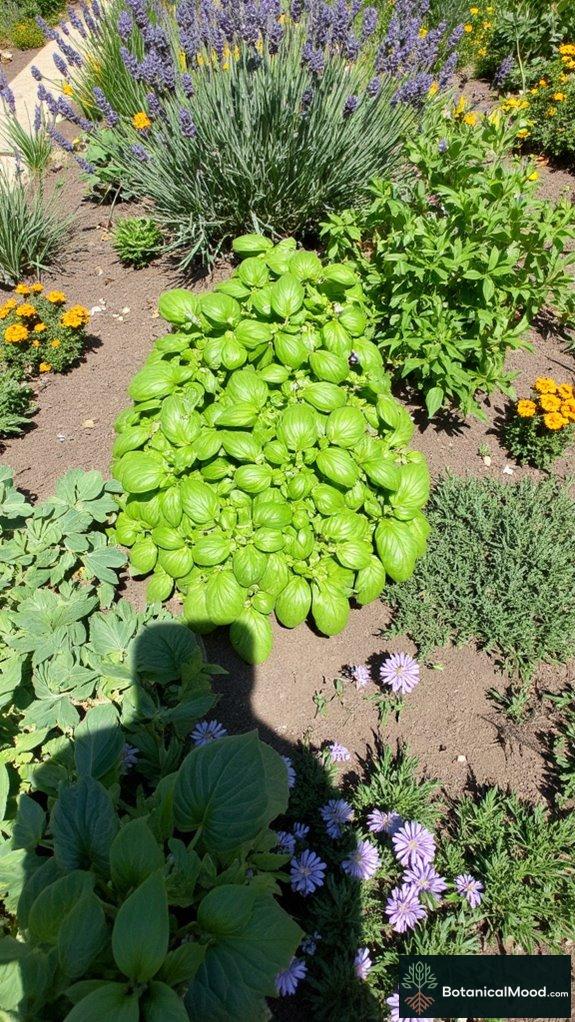
Creating a pollinator-friendly herb garden not only supports the ecosystem but also enriches the flavor profile of your culinary herbs.
I love planting a diverse array of options like fragrant basil, vibrant dill, and blooming chives, which attract bees and butterflies. Incorporating flowering companions such as marigolds or lavender not only adds color but heightens the aromatic experience while cooking.
Using organic mulch retains moisture and lets your herbs thrive naturally, enhancing their taste.
Enhancing the flavor of your herbs starts with organic mulch, which nurtures moisture and promotes natural growth.
These choices foster a harmonious garden environment, creating a sensory haven I cherish.
I believe that a thriving garden reflects both beauty and sustainability, which I aim to share through Botanical Mood.
Herb Garden Companion Success Stories
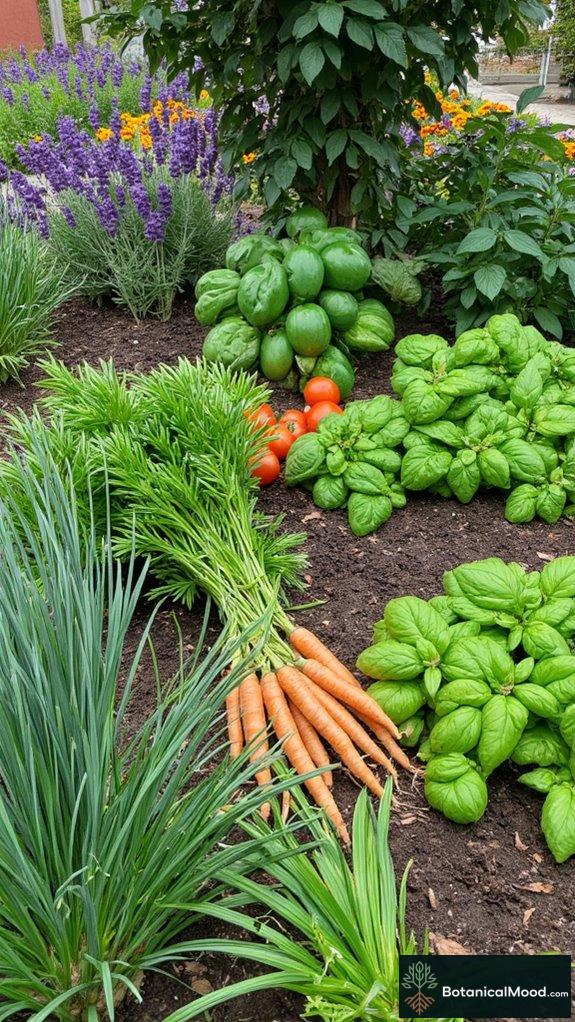
Herb gardens thrive when carefully planned companion planting creates a dynamic ecosystem, showcasing vibrant partnerships that not only repel pests but also enhance growth.
I’ve seen wonderful success with these combinations:
- Chives and carrots: Chives deter aphids, ensuring a bountiful carrot harvest.
- Basil and tomatoes: This pairing strengthens flavor while keeping harmful insects at bay.
- Lavender under fruit trees: Lavender wards off pests, preserving the delicate fruit above. Additionally, planting Nasturtium nearby can help repel aphids and squash bugs, further protecting these valuable crops.
These symbiotic relationships not only elevate plant health but also cultivate a lush, thriving environment that resonates with nature’s beauty and balance.
Isn’t that what every gardener dreams of?
Organic Herb Pairing Schema

When planning a thriving organic herb garden, understanding compatibility among various herbs transforms a simple patch into a vibrant ecosystem that benefits both plants and gardeners alike.
For instance, rosemary flourishes alongside sage and thyme, as they share similar needs for dry, well-drained soil. Basil and chives prefer moisture and should be kept away from drought-loving neighbors like oregano.
I love using companion plants such as chamomile to enhance flavors and attract beneficial insects. This thoughtful pairing not only fosters healthy growth but also crafts a beautiful, aromatic space.
Embrace these connections, and your herb garden will thrive in harmony.
Meet the Herb Garden Creator
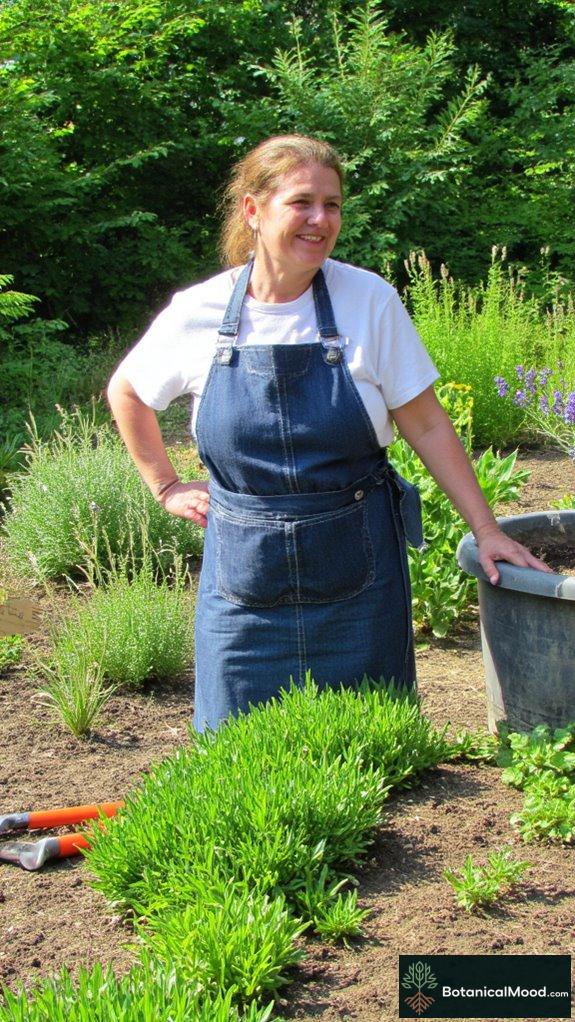
Mary Worthen, from Arkansas, was inspired by her family’s rich tradition of herbal remedies, igniting her passion to cultivate a medicinal herb garden that honors historical practices and promotes health.
To design her garden, Worthen meticulously researched historical texts, such as the *Dispensatory of the United States of America*, and incorporated regional herb references. Her thoughtful approach focused on creating a space that highlighted the medicinal value of various herbs, blending historical evidence with practical gardening techniques.
Using tools from brands like Fiskars for precision cutting and Earthway for effective planting, Worthen cultivated her garden meticulously.
Accessories such as decorative plant labels and drip irrigation systems were installed, ensuring the garden thrived while paying homage to traditional horticultural methods and influential herb gardeners.
Popular Aromatic Garden Selections
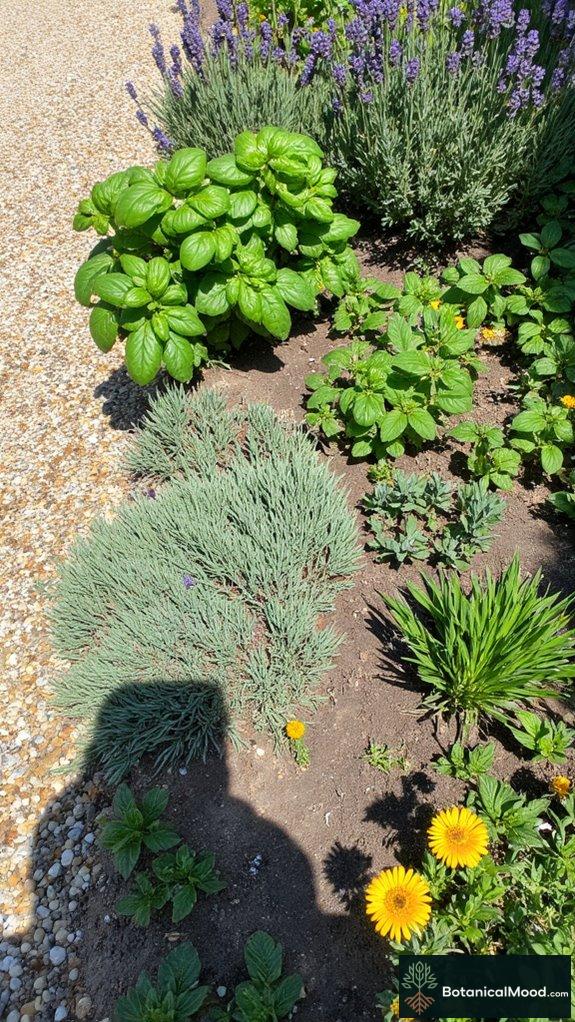
Creating a vibrant aromatic garden involves choosing a selection of herbs that not only elevate the olfactory experience but also contribute to a healthy ecosystem. Among my favorites are:
- Lavender – This quintessential herb thrives in hot, arid conditions and enhances the garden with its calming fragrance.
- Chamomile – As a gentle companion, it attracts beneficial insects and offers fragrant blooms, making tea a delightful bonus.
- Peppermint – Its strong aroma repels pests while enriching the flavors of its neighboring plants, creating a lush culinary haven.
These selections elevate both aroma and allure, ensuring a bountiful, harmonious garden.
References
- https://journeywithjill.net/gardening/2023/05/03/companion-planting-herbs-in-containers/
- https://www.bitesizedgardening.co.uk/companion-planting-facts-myths/how-to-dig-for-victory/
- https://extension.wvu.edu/lawn-gardening-pests/gardening/garden-management/companion-planting
- https://www.organicgardenco.com.au/blog/helpful-tips-for-your-garden/your-guide-to-companion-planting-herbs-combination/
- https://www.plantsandflowersfoundationholland.org/en/companion-planting-herb-garden/
- https://backyardpatch.blogspot.com/2011/05/herb-of-week-companion-planting.html
- https://www.farmanddairy.com/top-stories/how-to-choose-the-right-companion-plants-for-herbs/770734.html
- https://www.attainable-sustainable.net/companion-planting/
- https://savannabel.com/2016/01/18/companion-planting-lovers-warriors-in-the-garden/
- https://www.youtube.com/watch?v=hQnvdkoSUGc
- https://www.azurefarmlife.com/farm-blog/companion-planting-chart-for-a-healthier-happier-garden
- https://www.growcreatesip.com/blog/companion-planting-chart-for-herbs
- https://www.motherearthnews.com/organic-gardening/herbal-companion-planting-ze0z1804zmos/
- https://en.wikipedia.org/wiki/John_Gerard
- https://www.herbsocietyny.org/our-history
- https://gardens.si.edu/collections/archives/timeline-of-american-garden-history/
- https://seedsistas.co.uk/2023/03/23/history-of-herb-gardens/
- https://dammanns.com/2025/03/31/herbs-as-companion-plants/
- https://www.gardenersbasics.com/tools/blog/best-companion-plants-for-peppermint-herb
- https://www.gardenia.net/guide/companion-planting-with-herbs
- https://www.finchandfolly.com/companion-planting
- https://herbsathome.co/most-aromatic-herbs/
